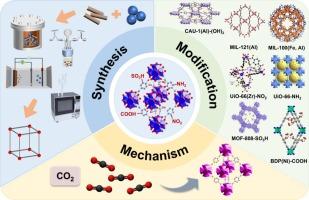二氧化碳捕获的金属有机框架:通过修改策略调整结构和功能
IF 13.2
1区 工程技术
Q1 ENGINEERING, CHEMICAL
引用次数: 0
摘要
温室气体带来的挑战,特别是二氧化碳(CO2),代表了现代社会面临的最紧迫的环境危机之一。碳捕获作为碳循环中的一个关键过程,要求材料具有特定的性能。然而,开发全面满足这些标准的碳捕获材料仍然是一项艰巨的任务。目前的研究表明,金属有机框架(mof)是解决这一环境挑战的有前途的材料。由于mof结构的多样性,可以通过掺杂金属、引入官能团等修饰来调整其吸附性能。本文综述了改性MOFs吸附CO2的研究进展。在这篇综述中,我们确定了改性前后mof的变化,比较了单金属mof和双金属mof,以及具有各种官能团(如-NO2, -OH, -COOH, -SO3H等)的mof和复合mof。通过评价不同改性方法的优缺点,进一步优化改性策略,提高mof的吸附性能和选择性。此外,我们还讨论了有助于实现更高捕获能力和选择性的合成和吸附机制,以及它们的成本和再生性能。简而言之,在设计平衡选择性和吸附能力的材料时,必须考虑多种因素。本文章由计算机程序翻译,如有差异,请以英文原文为准。

Metal-organic frameworks for CO2 capture: Tailoring structure and function through modification strategies
The challenge posed by greenhouse gases, particularly carbon dioxide (CO2), represents one of the most pressing environmental crises confronting modern society. Carbon capture, as a crucial process within the carbon cycle, demands materials with specific properties. However, the development of carbon capture materials that comprehensively satisfy these criteria remains an arduous task. Current investigations reveal metal-organic frameworks (MOFs) as promising materials for tackling this environmental challenge. Due to the structural diversity of MOFs, their adsorption properties can be tailored through modifications, such as metal doping and functional group introduction, etc. This review aims to provide a comprehensive overview and update on the development of MOFs modification for CO2 adsorption. In this review, we identify the changes in MOFs before and after modification, comparing monometallic and bimetallic MOFs, as well as MOFs with various functional groups (e.g., -NO2, -OH, -COOH, -SO3H, etc.), and composite MOFs. By evaluating the advantages and disadvantages of different modification methods, the modification strategies can be further optimized to improve the adsorption properties and selectivity of MOFs. Additionally, we discuss the synthesis and adsorption mechanisms that contribute to achieving higher capture capacities and selectivity, as well as their costs and regeneration performance. In short, it is essential to consider multiple factors when designing materials that balance both selectivity and adsorption capacity.
求助全文
通过发布文献求助,成功后即可免费获取论文全文。
去求助
来源期刊

Chemical Engineering Journal
工程技术-工程:化工
CiteScore
21.70
自引率
9.30%
发文量
6781
审稿时长
2.4 months
期刊介绍:
The Chemical Engineering Journal is an international research journal that invites contributions of original and novel fundamental research. It aims to provide an international platform for presenting original fundamental research, interpretative reviews, and discussions on new developments in chemical engineering. The journal welcomes papers that describe novel theory and its practical application, as well as those that demonstrate the transfer of techniques from other disciplines. It also welcomes reports on carefully conducted experimental work that is soundly interpreted. The main focus of the journal is on original and rigorous research results that have broad significance. The Catalysis section within the Chemical Engineering Journal focuses specifically on Experimental and Theoretical studies in the fields of heterogeneous catalysis, molecular catalysis, and biocatalysis. These studies have industrial impact on various sectors such as chemicals, energy, materials, foods, healthcare, and environmental protection.
 求助内容:
求助内容: 应助结果提醒方式:
应助结果提醒方式:


